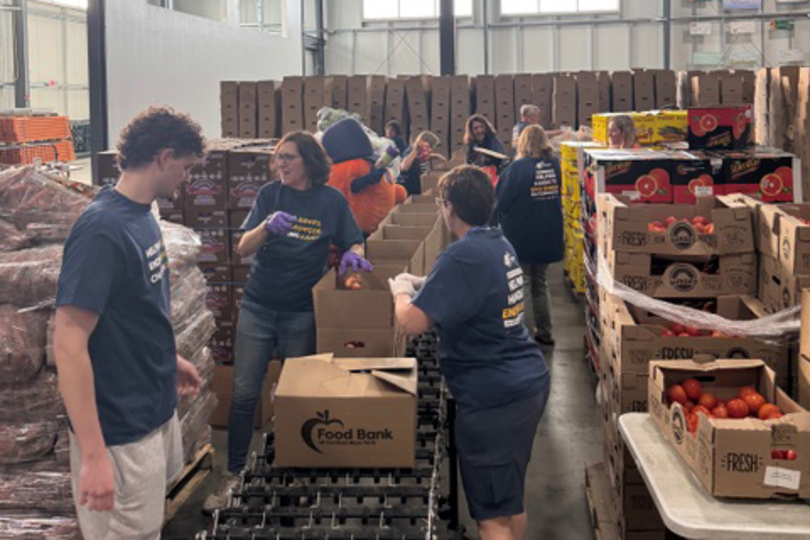Food Bank of Central NY faces cuts as Trump reduces federal spending

With the Trump administration’s efforts to reduce government funding, Food Bank of Central New York is facing cuts due to its reliance on federal programs. The Department of Agriculture is cutting $500 million in food bank grants. Courtesy of Karen Belcher
Get the latest Syracuse news delivered right to your inbox.
Subscribe to our newsletter here.
While tabling at the state fair, Karen Belcher remembers a woman bringing her and the rest of the Food Bank of Central New York team iris flowers to plant near its walkway. The flowers, which Belcher calls a symbol of hope and resilience, are still growing at its office today.
While President Donald Trump continues efforts to reduce federal spending, Food Bank of CNY faces funding cuts. Belcher, the food bank’s executive director, said its future is unclear, as it relies heavily on grant funding from the United States Department of Agriculture.
“Every spring when they (bloom) it reminds us of almost that rebirth, that look at what we made it through,” Belcher said. “Look at where we are now, and we’re still here and we’re going to still be here.”
In March, the USDA eliminated $500 million from emergency food systems, cutting the food bank’s $2 million grant. The grant provided funding to programs that purchase foods produced within New York state or within 400 miles of its delivery locations.
Belcher said federal cuts made to the Supplemental Nutrition Assistance Program, a program that helps low-income Americans afford groceries, could also negatively impact families relying on it.
“SNAP is the first line of defense for food insecurity,” Belcher said. “Cuts would be detrimental to our communities.”
Despite the cuts, Food Bank of CNY is expanding its access into its 40th year of service, Development Manager Heidi Soine said. The food bank is working toward a major warehouse expansion and new food distribution programs.
In its 2024 impact statement, Food Bank of CNY estimated over 170,000 people in its service areas face food insecurity. In Onondaga County alone, about 45,000 residents experience food insecurity, according to Syracuse-Onondaga Food Systems Alliance.
The COVID-19 pandemic and economic factors have also worsened the food crisis, according to Boston University. To help meet growing demand, Food Bank of CNY launched an $8.5 million warehouse expansion in June 2023, adding nearly 34,000 square feet to its facility, including 6,000 square feet of new office and storage space.
The expansion allows the organization to operate more efficiently and serve its network of partners, including religious organizations, social services, schools, community centers, food pantries and soup kitchens.
Food Bank of CNY also focuses on sustainability and reducing food waste, Belcher said. The food bank sends unhealthy foods to drug rehabilitation centers to aid those in withdrawal and its food waste is donated to local pig farmers.
Mobile Food Pantry is the organization’s newest initiative aimed at addressing food deserts and access barriers. With 15 trucks, Soine said the food bank delivers directly to underserved families.
Over half of census tracts in Syracuse are considered food deserts, communities with residents living more than 1 mile from the nearest grocery store. People lacking access to fresh, healthy food are more likely to experience obesity and health issues according to a University of Texas at San Antonio Office of Research study.

Cole Ross | Digital Design Director
Food Bank of CNY’s five-year plan focuses on breaking down barriers to food access by expanding workforce development and financial literacy programs. The organization is hosting a September gala with a goal of raising over $300,o00 to provide 1 million meals to the community.
As a member of Feeding America, the food bank aims to eliminate hunger through partnership, education and advocacy as food insecurity rises across the region. Unlike food pantries that distribute food directly to the public, the food bank operates as a “food donation hub.”
It collects, stores and distributes food to partner organizations, creating an emergency food network to provide relief to people facing food insecurity. Food Bank of CNY serves Onondaga and 10 other counties in central New York, providing 22.2 million pounds of food, or 18.5 million meals, each year.
Mike Heppner, the organization’s chief people officer, emphasized the significance of its mission to create lasting change through giving back to the community.
“Everyone has a right to make sure that their stomachs are full and that there’s food on the table,” said Heppner, who joined the nonprofit over a year ago. “I think food is a basic human right, and I think that the most vulnerable people should have access to healthy, nutritious foods.”
Belcher, who’s worked with Food Bank of CNY for over 24 years, said the role of food banks has evolved since the organization’s establishment in 1985. She said the CNY bank now has a strong focus on nutrition and personal food preferences.
Before food banks existed, pantries often handed out pre-packed bags with limited variety, which Belcher said created issues. When families received food they wouldn’t eat, they remained hungry.
Food Bank of CNY offers over 300 food varieties through its online ordering system for partner agencies. Belcher said the organization acts as a “connector” in the food system, with nutrition as its core focus. By improving access to healthy options, Food Bank of CNY aims to address broader issues related to community well-being and create lasting change.
“We like to always say our goal is to work ourselves out of a job,” Heppner said. “I think the realistic future is to continue expanding on what we’ve done, and just make sure that our reach is able to get as far as we can to impact as many folks as we can.”






